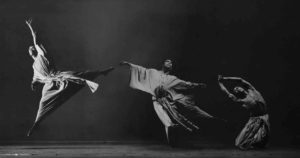Ailey: A beautiful, if not revealing, documentary - Vancouver Ballet Society
- Home
- Reviews 2020 - 2023
- Ailey: A beautiful, if not revealing, documentary

By Nadine Matthews
About midway through director Jamila Wignot’s most recent film, Ailey, the eponymous subject of the documentary muses in voiceover recording about “the agony” of growing up poor, with a single mother, in Jim Crow-era Texas. Alvin Ailey explains that, as a Black man, he was made to “feel as if you were nobody, just nothing.”
From such humble beginnings, Ailey defied great odds and formed a dance company that 60-plus years after its founding is one of the world’s preeminent modern dance groups. Alvin Ailey American Dance Theater has performed for tens of millions across six continents. Ailey himself won some of the most prestigious awards in the arts world. Several of his ballets, including 1960’s Revelations and 1971’s Cry, sit staunchly at the centre of the modern dance canon.

It almost goes without saying that there would be a film attempting to plumb the depths of the kind of individual who, with so little, forged such an impressive cultural legacy. Wignot’s Ailey, which premiered in January at the 2021 Sundance Film Festival, has a fascinating subject at its centre.
Ailey sets out to bring the viewer an intimate examination of the dance pioneer and the iconic dance company he founded in 1958 through interviews with Ailey’s peers, audio from one of his last interviews (Ailey passed away in 1989), archival photos and video, and skillfully utilized vintage footage evocative of the social and political landscape of his youth and early adulthood.
The film also follows hip-hop choreographer Rennie Harris as, along with company dancers, he rehearses a two-act work inspired by Ailey, called Lazarus. About five minutes in, when Harris is shown watching footage of a youthful Ailey, he states in voiceover, “I just sit there and watch, to find out what makes Mr. Ailey, Mr. Ailey.” This primes the viewer to expect to learn about the creative, business and marketing genius behind this successful modern dance company, whose works channelled the Black American experience before the Civil Rights movement reached its zenith.

But, not long after, Ailey’s own words hint we may not get very close to the man after all. Dance, Ailey states in his slightly gravelly, penetrating voice, “is disastrous for any personal relationships.” Ailey also discusses being “obsessed” with dance, indicating that perhaps there is little else to know: dance was his life. Former Ailey company dancer George Faison asserts that the only personal relationship Ailey’s colleagues knew of was the one with his mother. Indeed, the only personal relationships explored in Ailey are with his mother, a boyhood crush, and a lover who inexplicably disappeared from his life via a fire escape during a party.
Despite not revealing very much about Ailey the man, Wignot’s film has some lovely moments. Ailey’s overwhelming contribution to the dance world is brought to the fore with extensive archival footage that shimmers with the Ailey company dancers’ breathtaking elegance and power, in rehearsal and in performance, over the past 60 years. The unquestioned affection and respect Ailey’s colleagues (including his muse and successor as artistic director, Judith Jamison) had for him comes across clearly in interviews.
Dance legend and childhood friend Carmen de Lavallade recalls being impressed watching Ailey in gymnastics class before he became a dancer. Footage of the pair all grown up, onstage, costumed and performing together, follows, bringing a satisfying sense of lives coming full circle.
And there are sad moments. Jamison recounts having dinner with Ailey in New York City in 1988, when they listlessly pushed their food around, the air heavy with the unspoken truth that for Ailey, ill from AIDS, this meal was an act of putting his affairs in order.
Clearly, Ailey cordoned off aspects of his life, even as he oozed with the charisma that attracted dancers, collaborators and the type of benefactors necessary to finance his bold vision. A true wizard, Ailey remains hidden even after the curtain has been pulled back in Wignot’s documentary.

